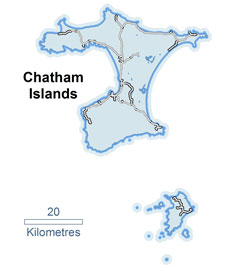Climate change projections for the Chatham Islands
This page provides an overview of how the climate in the Chatham Islands is likely to change in the future and what implications this has for the region.
This page provides an overview of how the climate in the Chatham Islands is likely to change in the future and what implications this has for the region.

Projections of climate change depend on future greenhouse gas emissions, which are uncertain. There are four main global emissions scenarios ranging from low to high greenhouse gas concentrations. This page presents regional projections as a range of values from a low emissions to a high emissions future.
The projected changes are calculated for 2031–2050 (referred to as 2040) and 2081–2100 (2090) compared to the climate of 1986–2005 (1995).
Compared to 1995, temperatures are likely to be 0.7˚C to 1.0˚C warmer by 2040 and 0.7˚C to 2.8˚C warmer by 2090.
By 2090 the Chatham Islands are expected to experience fewer frosts, and more days per year where maximum temperatures exceed 25˚C.
The Chatham Islands are expected to become wetter, particularly in winter and spring. Winter rainfall is projected to increase by 5 to 11 per cent by 2090 and spring rainfall is expected to increase by 6 to 8 per cent for the same period.
Extreme rainy days may become more frequent in the region.
Changes in wind direction may lead to an increase in the frequency of westerly winds over the Chathams by 2090.
New Zealand tide records show an average rise in relative mean sea level of 1.7 mm per year over the 20th century. Globally, the rate of rise has increased and further rise is expected in the future.
The Ministry for the Environment provides guidance on coastal hazards and climate change, including recommendations for sea level rise.
See Preparing for coastal change: A summary of coastal hazards and climate change guidance for local government. The guidance was updated in December 2017.
By 2090, the region could expect*:
| Spring |
|
|---|---|
| Summer |
|
| Autumn |
|
| Winter |
|
*Projected changes are relative to 1995 levels. The values provided capture the range across all scenarios. They are based on scenario estimates and should not be taken as definitive. For more information, see the full report on climate projections.
More heavy rainfall will increase the risk of flooding on the islands. For instance, higher water levels in Te Whanga lagoon after heavy rainfall could increase the risk of surface flooding of nearby roads.
Coastal roads and infrastructure may face increased risk from coastal erosion and inundation, increased storminess and sea-level rise.
Warmer, wetter conditions could increase the spread of pests and weeds.